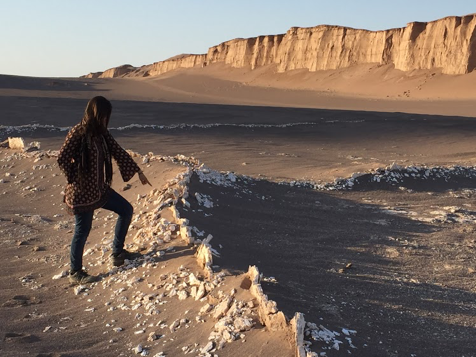Sand Dunes in Arabia Terra
I wanted to point out some features you might have noticed in the Planet Four: Ridges images. Dark wiggly blobs as shown in the images below are actually sand dunes on Mars.





We’re showing images from orbit, but to give you a sense of what some of these might look like from the ground, here’s a selfie of Mars Curiosity at “Namib Dune”, part of the informally named Bagnold Dune Field located in Gale Crater. I learned recently that on Mars, sand dunes are black because they are made of ground up basaltic lava rocks, just like black sand beaches of Hawaii are.

Image credit: NASA/JPL-Caltech/MSSS
More Planet Four – Introducing Planet Four: Ridges
Today we have a guest blog by JPL research scientist Laura Kerber. Laura studies physical volcanology, aeolian geomorphology, wind over complex surfaces, and the ancient Martian climate,
The surface area of Mars is almost the same as the area of all of the continents on Earth. Only a tiny fraction of these vast, untouched lands have been explored by rovers. Of the rest, much of it has still never been seen up close by human eyes. Today we’ve launched Planet Four: Ridges, and we are asking for your help to explore a particularly interesting part of the Red Planet. The goal is to find polygonal ridge networks, which are intersecting lattices of thin ridges enclosing polygonal shapes.

A polygonal ridge network in the eastern Arabia Terra region of Mars. This image shows an area about 4 kilometers across
Some of these ridges can be up to 50 meters tall, and from the surface would appear like the ramparts of an enormous fortress. Networks of ridges are usually formed via the filling of fracture networks either with lava, wind-blown sediment, or mineral deposits from circulating ground waters. These fractures are then transformed into ridges as the softer units around them get eroded by the wind. Your classifications on this site will help researchers find these networks and compare them to distributions of other features, such as mineral signatures, ancient valley networks, and dried up lakes. The images you see here are taken using the mid-resolution (6 meter per pixel) Context Camera (CTX) in orbit around Mars. Each participant views portion of images and decides whether or not there is a polygonal ridge network in the frame. We collect together everyone’s views on each image and this helps us find new ridge networks to study. The ridge networks can be subtle, but human eyes are well suited for pattern-finding, which is why we rely on you over computer algorithms.
More than 3.5 billion years ago, the climate of Mars was much different than it is today. The surface of Mars shows evidence for hundreds of lakes, and thousands of kilometers of flowing rivers. During this time and earlier, warm groundwater may have circulated in the Martian subsurface, potentially providing a protected home for early Martian life. One piece of evidence for groundwater during this period is the presence of clays that are deep in the crust (often visible in the central peaks of impact craters). Another is the presence of mineral veins, which are formed when warm water carrying elements in solution deposits minerals on the walls of fractures. Hot water or steam can also alter wall rocks of fractures, causing the walls to harden compared with the surrounding material. Later, after the crack cools, the minerals become harder than the rock types that surround them, so that as the surrounding unit get eroded by the wind, what was originally a fracture becomes a ridge.

A ridge network filled with the mineral gypsum located in the Lut Desert of Iran, one of the world’s hottest and most lifeless deserts

A close-up of a Lut Desert gypsum ridge
Not all polygonal ridge networks are formed due to circulating groundwater, however. Sometimes open cracks on the surface get filled with windblown dust and sand, and that part gets preserved. Lava can also fill up cracks, either as it rises through the subsurface as magma, or if it is flowing along and drips into a fracture network. Finding all of the ridge networks on Mars helps us untangle which networks were formed by which process, all the while learning more about the intriguing wetter period in Mars’ history. This project focuses on the Eastern Arabia Terra region of Mars, where several ridge networks suggestive of mineral veins have been found.

A crack that has been hardened by hot steam escaping. It has since been brought into relief by the erosion of the surrounding rock. Campo de Piedra Pomez, Argentina.
As the project continues, we hope to share more background information on these interesting features here on this blog. Meanwhile, why not go find some ridge networks? Visit http://ridges.planetfour.org to start looking.
Four Years of Planet Four

Image Credit: catbeurnier– Flickr – original photo
January 8th, marked the 4th anniversary (well at least in Earth years!) of the launch of the one and only original Planet Four. We wanted to thank you for being on this journey with us for the past four Earth years. Our first science paper seems to always be delayed, but I and the rest of the science team are dedicated to getting this paper out the door. The science team is virtually meeting on Wednesday to discuss what I hope is the freezing of the development of the classification clustering algorithm. That’s the hurdle in our way, and over the past Earth year Michael has made great strides dealing with the major issues we needed to tackle to get the science from your clicks. Thank you for your time and effort on the site. We still need you, and new data from Manhattan Season 5 is now live on the site. So go check it out and classify some fans and blotches at http://www.planetfour.org.
Planet Four has been able to show that a citizen science approach beyond crater identification with Mars orbital imagery works. The science team was invited this past fall to showcase Planet Four at a workshop focused on citizen participation in Mars exploration hosted by NASA Headquarters. Planet Four’s successes, has spawned other Mars Zooniverse citizen science projects: Planet Four: Terrains (which has already produced results with Mars Reconnaissance Orbiter pointing HiRISE and new locations on the Martian South Pole) and a birthday gift if you like that is coming tomorrow! Stay tuned to this space for more tomorrow! We can’t wait to share this new endeavor with you all.
Thank you for the past four years and onward to Year 5!
New tiny spiders develop on Mars NOW!
Hi everybody!
I would like to share with you our new paper that just got published in January volume of Icarus journal.
The most exciting part of this paper is that HiRISE detected some new troughs in Martian polar areas. The troughs were not visible when the HiRISE observed those locations for the first time in Martian Years (MY) 28 and 29. But when we have commanded HiRISE to take repeated observations in MY 30 and 32, we were rewarded with images of new features that you can see in the animated image below.
The troughs are really small: the whole image is less than 200 m across, while the new troughs are only up to 1 m wide. The total length of them reaches 582 m thanks to their multiple branches.
The new troughs, large enough for HiRISE to detect, are created under the current climate condition – and this is really a big deal. They do look much like spiders: they have different tributaries and resemble the dendritic nature of the large spiders. And they are developing. In turn this means that the large spiders might be developing right now as well. We are still waiting to see topographical changes on the large and fully developed spiders, but we know now that the process is able to erode away quite some ground material. For example, the volume of the material that was moved to create the troughs in the image above is 24 m², they were created over 3 MY, meaning, the process moved 8 m² yearly only in this one example.
The erosion rates like this lets us evaluate the age of the large spiders. They take amazing 1.3 thousands Martian years! It is a long time for a human being, but it is really just a blink of an eye for a geological feature.
We are continuing to monitor these locations to check if these troughs will not be erased in the next years. It well may happen because the new spiders are located very close to the dune fields, and moving sand is capable to cover or sand-blast these small topographical features barely in a year.
The official copy of the paper can be found here and JPL press-release about it is here. You may also read the article from Universe Today about this paper here.
Anya
Before the Sunlight Leaves
A quick update on Planet Four: Terrains. I’m working on the first paper draft and planning on submitting it to a science journal by early February with any luck. Currently the draft is being iterated on; I’m incorporating comments and feedback from the rest of the science team. The paper focuses on the distribution of spider features on the South Pole based on Planet Four: Terrains assessments. So stay tuned for more on that over the coming months.
In the meantime, I’ve also processed the subject images currently retired from the newest set of images on the site. We’ve found interesting areas with spiders and baby spiders that we’d like to get a closer look at. We’re hoping that HiRISE will image these over the coming months. The days on the South Pole are getting shorter. May 5th 2017 marks the official start of Southern Fall Equinox. In a few months time, we’ll have to wait approximately 2 Earth years for an opportunity to image interesting regions of the South Pole with HiRISE found by Planet Four: Terrains.
Processing the retired subjects from the current set of CTX images on the site, we found four new regions of interest thanks to your collaboration that we want to take a better look at. We have requested HiRISE imaging. So the race is on to get through as many of the P4: Terrains subject images as we can before there won’t be enough sunlight for HiRISE observations. If you can spare some time, place help classify an image or two for spiders, baby spiders, channel networks, swiss cheese terrain, and craters on http://terrains.planetfour.org

